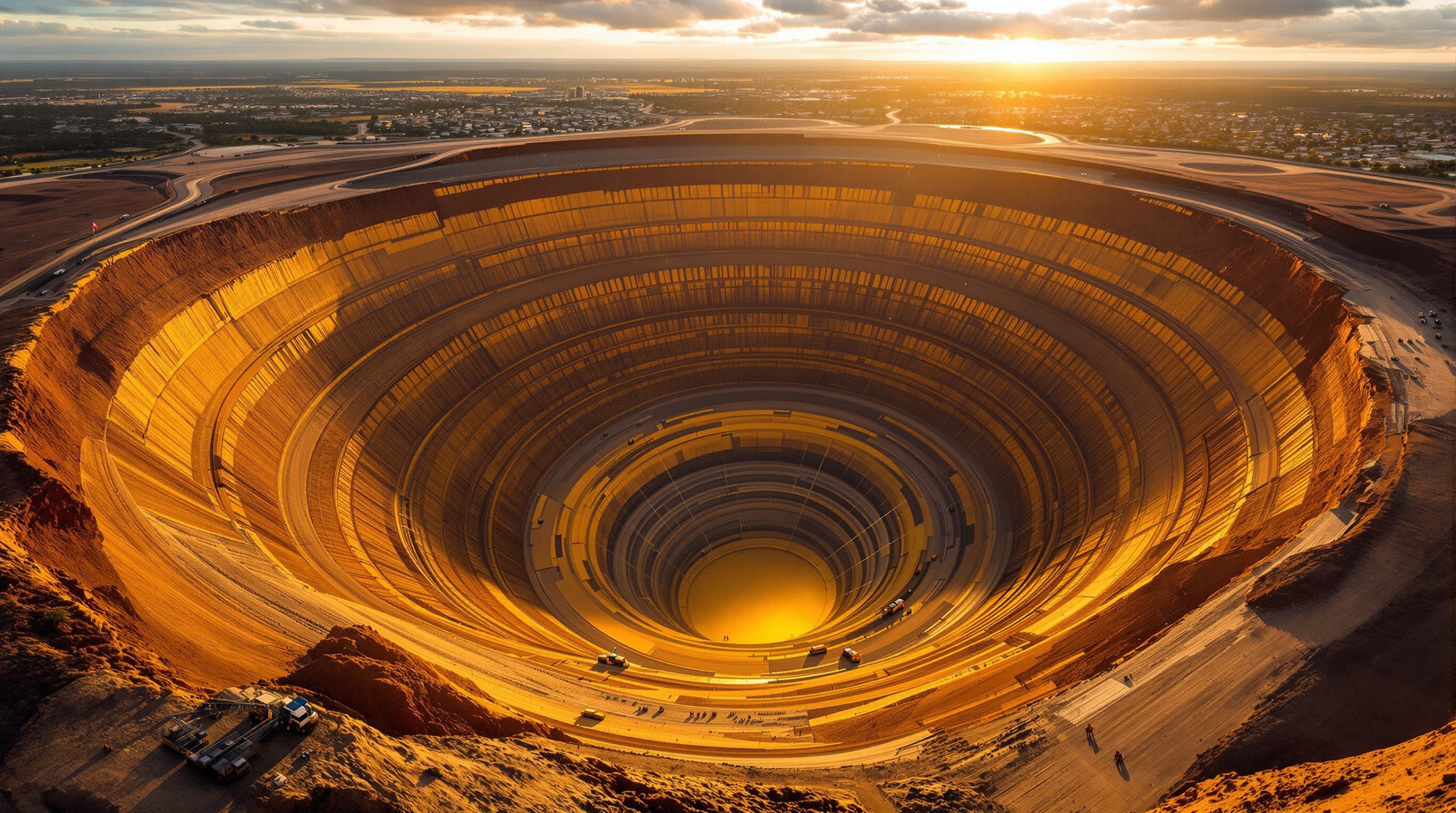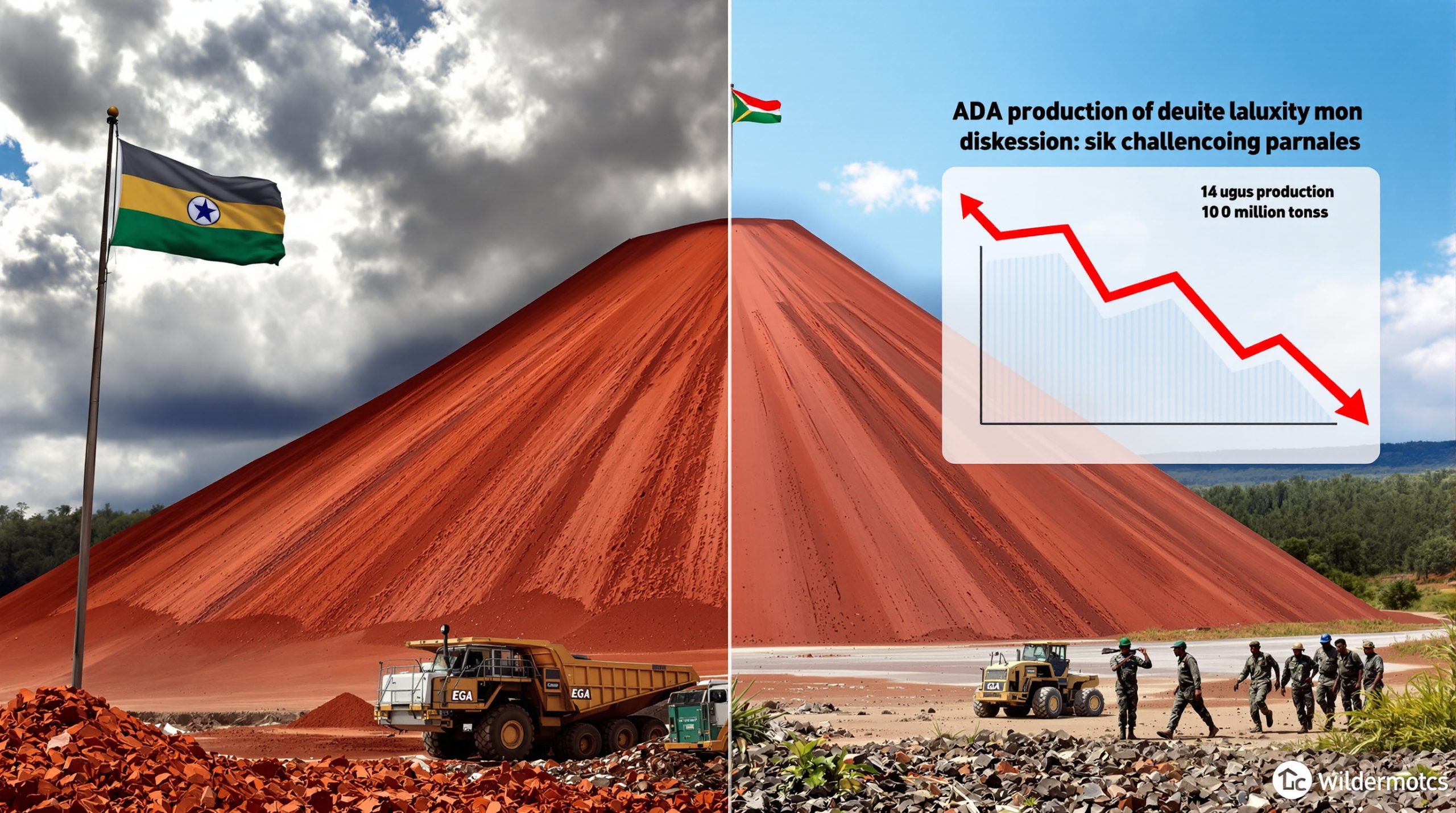Energy Fuels Achieves Historic Milestone: First U.S. Dysprosium Oxide Production at 99.9% Purity
Energy Fuels Inc. (NYSE American: UUUU | TSX: EFR) has reached a significant milestone in American rare earth processing by producing one kilogram of 99.9% pure dysprosium oxide at its White Mesa Mill in Utah. This achievement marks the first time a substantial pre-commercial quantity of high-purity dysprosium oxide has been produced on U.S. soil, representing a critical step toward establishing domestic rare earth supply chain independence.
The achievement signals a potential turning point for American manufacturing and national security, as dysprosium is crucial for high-performance technologies yet has historically been sourced almost exclusively from China. This breakthrough comes at a crucial time when the demand for critical minerals energy transition is accelerating globally.
The Technical Achievement Behind the Milestone
The company utilized a demonstration-scale solvent extraction (SX) system designed and built entirely in-house by American chemical process engineers. This innovative system leverages the team's extensive experience with solvent extraction technology and builds upon their previous success in creating the first commercial-scale light rare earth separation system constructed in the United States since the 1980s.
The breakthrough required overcoming significant technical challenges, as rare earth elements are notoriously difficult to separate due to their similar chemical properties. Energy Fuels' engineering team developed specialized techniques to achieve the 99.9% purity level needed for commercial applications, implementing modern mining technology to optimize their processes.
Standing Apart from Other U.S. Efforts
While several companies have announced plans for heavy rare earth production in the United States, Energy Fuels stands out as the first to publicly disclose actual production quantities and purity levels for dysprosium oxide. The company's approach using modern solvent extraction techniques differentiates it from competitors who may be relying on older, less economical ion-exchange methods for laboratory samples.
As Jack Lifton of InvestorNews noted in August 2025, "Energy Fuels is the first U.S. company to publicly produce high-purity Dy and reveal actual production quantities, underscoring the uniqueness of this milestone."
Why Heavy Rare Earths Are Critical for U.S. Manufacturing
Heavy rare earth elements, particularly dysprosium and terbium, are essential components in high-performance permanent magnets used in electric vehicle motors, wind turbines, and defense systems. These elements enable magnets to maintain their magnetic properties at high temperatures, making them crucial for advanced technology applications.
Without dysprosium and terbium additives, neodymium-iron-boron (NdFeB) magnets would quickly lose their magnetic properties when operating at higher temperatures—a critical limitation for electric vehicle motors and wind turbines that must function reliably in demanding conditions.
The Domestic Feedstock Challenge
Despite the technical capability to separate heavy rare earths, the United States faces a significant challenge: the lack of domestic heavy rare earth feedstock. Unlike light rare earths (such as neodymium and praseodymium), which are found at MP Materials' Mountain Pass mine in California, heavy rare earths like dysprosium and terbium are not currently mined in substantial quantities within U.S. borders.
This creates a critical vulnerability in the supply chain, as even with separation capabilities, processors must still import heavy rare earth-bearing concentrate or intermediates from overseas sources. The establishment of a critical minerals reserve strategy has become increasingly important to address this vulnerability.
Current Supply Chain Vulnerabilities
Without domestic sources of heavy rare earth-bearing ore or concentrate, U.S. manufacturers remain dependent on imported feedstock, primarily from China or allied nations. This dependency creates a critical vulnerability in the supply chain for high-technology products and defense applications.
The Department of Defense has identified this vulnerability as a national security concern, which has driven increased investment in domestic rare earth processing capabilities through various funding initiatives and strategic partnerships. The recent critical minerals executive order further emphasizes the importance of securing these resources.
How Lynas Factors into the Global Heavy Rare Earth Market
Lynas Rare Earths Ltd. (ASX: LYC) has also made significant progress in heavy rare earth separation outside the United States. The company commissioned a new heavy rare earth separation circuit at its Malaysia plant in early 2025, successfully producing dysprosium oxide in May and terbium oxide in June of that year.
This achievement established "Lynas as the world's only commercial producer of separated heavy REEs outside of China," according to industry reports from InvestorNews in August 2025.
Lynas' U.S. Plans and DoD Support
Supported by the U.S. Department of Defense, Lynas is constructing a heavy rare earth separation facility in Texas. This plant will process intermediate products shipped from Australia, with the raw material sourced from Lynas's Mt Weld mine. Once operational (targeted for 2026), this facility will provide a domestic American source of heavy rare earth oxides, though the mining will still occur overseas.
The U.S. government's strategic partnership with Lynas demonstrates the priority placed on establishing domestic processing capabilities, even while the search for viable domestic mining operations continues.
What Makes Energy Fuels' Donald Project a Game-Changer
Energy Fuels is working to address the heavy rare earth feedstock gap through its Donald project in Victoria, Australia, jointly owned with Astron Corp. (ASX: ATR). This mineral sands deposit contains both monazite and xenotime, with the latter fraction containing exceptionally high concentrations of heavy rare earth elements.
The Donald Project represents a potential vertical integration strategy that could transform Energy Fuels from a processor into an integrated producer with control over both mining and processing operations, following the latest mining innovation trends in the industry.
Donald's Exceptional Heavy Rare Earth Content
According to Energy Fuels' production announcement, the Donald Project is one of the richest known sources of heavy rare earths globally, with rare earth concentrate expected to contain approximately 0.37% terbium and 2.15% dysprosium (on a total rare earth oxide basis). This concentration is significantly higher than typical light rare earth deposits.
These percentages may seem small, but they represent extraordinary enrichment compared to most rare earth deposits worldwide, which typically contain much lower proportions of these valuable heavy elements.
Projected Production Impact on U.S. Supply
At full planned Phase 1 production (approximately 7,100 tonnes of concentrate annually), the Donald Project could yield about 16 tonnes of terbium oxide and 92 tonnes of dysprosium oxide per year. These volumes would represent approximately 23% of U.S. terbium requirements and 34% of dysprosium needs, making it a substantial contributor to domestic supply.
Such production levels would significantly reduce U.S. dependence on Chinese sources for these critical materials, enhancing national security and industrial competitiveness in high-technology manufacturing sectors.
What This Means for U.S. Rare Earth Supply Chain Development
Energy Fuels' achievement represents a significant step toward establishing a more resilient domestic rare earth supply chain in the United States. By combining technical expertise in separation with access to rich heavy rare earth resources, the company is positioning itself as a potential cornerstone of America's rare earth magnet manufacturing independence.
The development comes at a crucial time when global competition for rare earth resources is intensifying, with countries worldwide recognizing the strategic importance of these materials for the green energy transition and advanced defense systems.
Integration of Mining and Processing
When the Donald project begins shipping monazite and xenotime concentrate to White Mesa (potentially by 2027, pending a 2025 production decision), Energy Fuels could become the largest U.S.-based producer of high-purity dysprosium and terbium oxides. This vertical integration would address a critical gap in the domestic supply chain.
As noted by industry analysts, "When Donald's monazite/xenotime output begins flowing to White Mesa, Energy Fuels will become the largest U.S.-based producer of high-purity dysprosium and terbium oxides ready for conversion into metals and permanent magnets."
Implications for U.S. Manufacturing
The development of domestic heavy rare earth oxide production capabilities could significantly reduce U.S. dependence on Chinese supplies for these critical materials. This would strengthen national security, support the growth of high-tech manufacturing, and enhance the resilience of supply chains for electric vehicles, wind turbines, and defense applications.
Industry experts believe this could catalyze further investment in downstream processing, potentially leading to the establishment of rare earth metal, alloy, and magnet manufacturing facilities within U.S. borders.
How Solvent Extraction Technology Works for Rare Earth Separation
The solvent extraction process used by Energy Fuels represents a sophisticated chemical engineering approach to separating individual rare earth elements from mixed concentrates.
This technology, while well-established in theory, requires significant expertise and specialized equipment to implement at commercial scale—expertise that had largely disappeared from the United States until companies like Energy Fuels began rebuilding these capabilities.
The Separation Challenge
Rare earth elements are notoriously difficult to separate from one another due to their similar chemical properties. Traditional methods like ion exchange are effective but extremely costly and inefficient at commercial scale.
The challenge stems from the fact that rare earth elements occupy adjacent positions on the periodic table, giving them nearly identical chemical behavior. Separating elements like dysprosium from terbium requires hundreds of separation stages and precise control of chemical conditions.
Modern Solvent Extraction Advantages
Solvent extraction involves using organic solvents to selectively extract specific rare earth elements from aqueous solutions. This process requires precise control of pH, temperature, and reagent concentrations, along with multiple extraction stages to achieve high purity levels.
The technology offers several advantages over older methods:
- Scalability: Can be expanded to commercial production volumes
- Cost-effectiveness: Lower operating costs than ion exchange once established
- Continuous operation: Unlike batch processes, solvent extraction can run continuously
- Selectivity: Modern extractants offer improved separation factors between adjacent rare earths
Energy Fuels has successfully adapted this technology to the specific challenges of heavy rare earth separation, demonstrating the company's technical capabilities in this specialized field.
Economic Implications of Domestic Heavy Rare Earth Production
The establishment of domestic heavy rare earth oxide production carries significant economic implications beyond just supply chain security.
The economic benefits extend throughout multiple industrial sectors, creating opportunities for workforce development, technological innovation, and manufacturing revival in regions that have experienced industrial decline.
Value Addition and Job Creation
Processing rare earth concentrates into high-purity oxides represents substantial value addition compared to simply mining and exporting raw materials. This vertical integration creates high-skilled jobs in chemical engineering, process control, and advanced manufacturing.
The following table illustrates the approximate value multiplication at each stage of rare earth processing:
| Processing Stage | Approximate Value Multiplier |
|---|---|
| Raw ore/mineral sand | 1x (baseline) |
| Mixed rare earth concentrate | 3-5x |
| Separated rare earth oxides | 15-25x |
| Rare earth metals | 25-50x |
| Alloys and magnets | 50-100x |
This value chain demonstrates why countries like China have historically prioritized developing the entire rare earth processing ecosystem rather than simply exporting raw materials.
Downstream Manufacturing Opportunities
Domestic production of heavy rare earth oxides could catalyze the development of downstream industries, including metal production, alloy manufacturing, and permanent magnet fabrication. These industries represent high-value segments of the rare earth supply chain currently dominated by Chinese companies.
The establishment of a complete rare earth value chain would create opportunities for:
- Metal reduction facilities: Converting oxides to pure metals through specialized metallurgical processes
- Alloy manufacturers: Producing precise mixtures of rare earth and transition metals
- Magnet producers: Creating high-performance permanent magnets for motors and generators
- End-use manufacturers: Producing electric vehicles, wind turbines, and defense systems with domestically-sourced components
FAQs About U.S. Rare Earth Production
Why is dysprosium oxide production significant for the United States?
Dysprosium is critical for high-performance permanent magnets used in electric vehicles, wind turbines, and defense systems. Domestic production reduces dependence on foreign suppliers, particularly China, which currently dominates global heavy rare earth processing.
Without dysprosium additives, the magnets in electric vehicle motors would lose their magnetic properties at operating temperatures, making the vehicles impractical. Similarly, wind turbines and many defense systems rely on dysprosium-containing magnets for efficient operation.
How does Energy Fuels' achievement compare to other U.S. rare earth developments?
Energy Fuels has demonstrated actual production of high-purity dysprosium oxide using modern solvent extraction technology, distinguishing it from companies that may have announced plans but not yet achieved similar results or disclosed specific production details.
While several U.S. companies have announced rare earth separation initiatives, Energy Fuels is the first to publicly disclose production of high-purity dysprosium oxide at a pre-commercial scale using industrial solvent extraction techniques rather than laboratory-scale methods.
What challenges remain for establishing a complete U.S. rare earth supply chain?
Major challenges include:
- Feedstock sourcing: Securing reliable sources of heavy rare earth-bearing minerals
- Scaling production: Moving from demonstration to commercial-scale separation
- Metal production: Establishing capacity to convert oxides to metals and alloys
- Magnet manufacturing: Developing expertise in sintering and magnetization
- Workforce development: Training specialized engineers and technicians
- Cost competitiveness: Achieving production costs comparable to international suppliers
When might the U.S. achieve self-sufficiency in heavy rare earth production?
Complete self-sufficiency remains several years away, with Energy Fuels' Donald Project potentially contributing significant domestic supply by 2027-2028. Lynas' Texas facility may begin producing heavy rare earth oxides from Australian feedstock by 2026.
However, true self-sufficiency would require development of domestic mining operations for heavy rare earth-bearing minerals, which remains a longer-term challenge. The current strategy focuses on securing allied nation supply chains while developing domestic processing capabilities.
Disclaimer: This article contains forward-looking statements regarding production timelines, capacity estimates, and market impact. Actual results may differ materially from these projections due to technical challenges, market conditions, regulatory approvals, or other factors. Investors should conduct their own due diligence before making investment decisions based on these developments.
What market factors will influence the success of domestic heavy rare earth production?
Several key factors will determine the commercial viability of U.S. heavy rare earth production:
- Chinese export policies: Restrictions or quotas on Chinese exports could increase prices and improve competitiveness of non-Chinese producers
- EV market growth: Faster-than-expected electric vehicle adoption would increase demand for dysprosium
- Processing technology advances: Improvements in separation efficiency could reduce production costs
- Government support: Continued defense funding and potential tax incentives for domestic production
- Downstream integration: Development of U.S.-based magnet manufacturing to create domestic demand
Keen to Stay Ahead with Real-Time Discovery Alerts?
Discover how subscribing to Discovery Alert can instantly provide you with significant mineral discoveries on the ASX, thanks to the cutting-edge Discovery IQ model. Explore the potential for historic returns on Discovery Alert's dedicated discoveries page and start your 30-day free trial to secure a competitive edge in the market.




